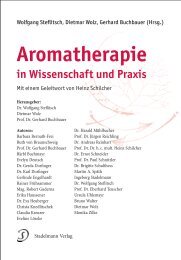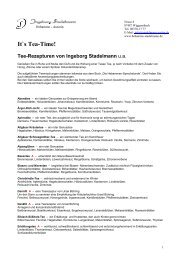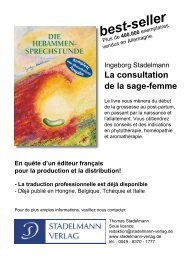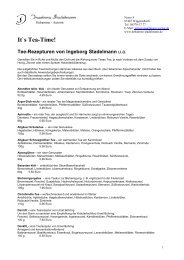STADELMANN VERLAG
STADELMANN VERLAG
STADELMANN VERLAG
You also want an ePaper? Increase the reach of your titles
YUMPU automatically turns print PDFs into web optimized ePapers that Google loves.
Stadelmann<br />
Verlag
© Stadelmann Verlag; September 2008<br />
2
© Stadelmann Verlag; September 2008<br />
I would like to dedicate this book<br />
to all the children who are being born<br />
this very moment,<br />
and all parents<br />
who receive their child<br />
in its own<br />
way of being.<br />
3
© Stadelmann Verlag; September 2008<br />
4
© Stadelmann Verlag; September 2008<br />
Ingeborg Stadelmann<br />
A Consultation with a Midwife<br />
Sensitive, natural guidance<br />
through pregnancy, childbirth,<br />
the postnatal period and breastfeeding<br />
with<br />
herbal medicine,<br />
homoeopathy and<br />
aroma therapy<br />
5
© Stadelmann Verlag; September 2008<br />
Nota bene<br />
This book serves the purposes of elucidation, information and self-help. Every reader is called<br />
upon to decide on her own whether – and to what extent – she should follow the suggestions<br />
for action and make use of the naturopathic applications. This book is not intended, however,<br />
to replace professional advice. In cases of doubt or if an illness has already set in, a midwife<br />
or doctor must be consulted in order to determine the correct diagnosis and the corresponding<br />
treatment.<br />
If used wrongly or in incorrect dosages, naturopathic substances can cause undesirable side<br />
effects. It is essential to pay close attention to the pointers and read the book carefully.<br />
Remember: “All things are poison and nothing is without poison; only the dosage keeps a<br />
thing from being poisonous!” (Paracelsus, alchemist and physician, 1493-1541)<br />
ISBN 13: 978-3-9803760-6-8<br />
© 1994 and 2005 Ingeborg Stadelmann<br />
Stadelmann Verlag, Nesso 7, 87487 Wiggensbaach<br />
Fax +49 (0)8370/8896<br />
www.stadelmann-verlag.de<br />
E-Mail: info@stadelmann-verlag.de<br />
Third printing of the thoroughly revised edition 2006<br />
Illustrations: Torill Glimsdal-Eberspacher, Betzigau<br />
Editing: Marina Burwitz, Munich<br />
The book and its parts are protected by copyright. Any utilization aside from the legally<br />
permissible cases therefore requires the previous written consent of the author.<br />
Translation by Judith Rosenthal<br />
English German Language Service<br />
Annotation:<br />
This copy of the translation »Die Hebammen-Sprechstunde« by Ingeborg Stadelmann is<br />
a pre-printed and preliminary version of the proofread work.<br />
Please do not hesitate to contact us for any improvements or interests for production or<br />
distribution. We are thankful to any ideas of improvement!<br />
6
© Stadelmann Verlag; September 2008<br />
Table of Contents<br />
Foreword to the Newly Revised Edition 9<br />
Foreword to the First Edition 12<br />
PREGNANCY 15<br />
THE FIRST THREE MONTHS 16<br />
Common Minor Problems during Early Pregnancy 18<br />
Medication and Dietary Supplements<br />
during Early Pregnancy 25<br />
Antenatal Care 27<br />
Naturopathy and Individuality 32<br />
Home Birth or Independent Birth Centre 33<br />
Partnership 34<br />
Antenatal Screening 35<br />
THE SECOND TRIMESTER 40<br />
Changes in the Body 40<br />
Antenatal Classes 43<br />
Natural Pregnancy 46<br />
Natural Support 47<br />
Nutrition and Dietary Supplements 49<br />
Common Minor Problems 51<br />
Partnership and Sexuality during Pregnancy 62<br />
The Home Birth 63<br />
Independent Birth Centres 64<br />
Twin and Multiple Pregnancies 65<br />
THE LAST THREE MONTHS 69<br />
Development / Sensory Organs 69<br />
Working Women / Maternity Rights and Benefits 71<br />
Preparation for Childbirth 72<br />
Changes in the Woman’s Body 72<br />
Preparing the Breasts for Breastfeeding 74<br />
Common Minor Problems 78<br />
Antenatal Care 91<br />
Assessing Contractions<br />
High-Risk Pregnancy / Hospitalization /<br />
95<br />
Preterm Childbirth 101<br />
Severe Problems during Pregnancy 103<br />
The Breech Position 115<br />
Partnership / Parenthood 123<br />
Baby Care 129<br />
Home Birth / Independent Birth Centre 130<br />
Early Discharge from the Hospital 135<br />
THE LAST SIX WEEKS –<br />
PREPARATIONS FOR CHILDBIRTH 143<br />
Moodiness and Pulsatilla 143<br />
“Very Pregnant” 145<br />
7
© Stadelmann Verlag; September 2008<br />
The Expectant Father / The Partner Relationship 145<br />
Going Swimming 146<br />
Choosing the Independent Birthing Centre or<br />
Maternity Unit 147<br />
Packing for the Hospital 151<br />
Birthing outside the Hospital 156<br />
Antenatal Care 159<br />
Problems during the Final Weeks 163<br />
Natural Methods of Preparation for Childbirth 170<br />
Postterm Pregnancy 180<br />
Inducing Labour 185<br />
Alternative Methods of Inducing Labour 188<br />
CHILDBIRTH 197<br />
THE BIRTH EVENT 198<br />
Natural Childbirth 198<br />
Operative Childbirth 207<br />
THE SIGNS OF LABOUR 210<br />
Contractions 211<br />
Rupture of the Membranes: The Water Breaks 215<br />
The Breaking of the Water from a Natural Perspective 221<br />
Methods of Establishing Contractions 223<br />
Mucous Discharge / Mucous Plug 224<br />
Bleeding 225<br />
Nausea / Vomiting 227<br />
Diarrhoea 228<br />
THE STAGES OF LABOUR 229<br />
Active Phase 229<br />
Transition Phase 230<br />
The Baby Makes Its Way through the Birth Canal 230<br />
[Maternal] Birthing Position 232<br />
The Woman in the Transition Phase 233<br />
Atmosphere in the Birthing Room 235<br />
The Function of the Contractions: The Turtleneck Principle 235<br />
Second Stage of Labour 236<br />
The Last Bit of Work 238<br />
The Hormonal Self-Regulation Mechanism 238<br />
THE BIRTH OF THE CHILD 241<br />
A Midwife’s Guidance 241<br />
How the Partner Can Help 243<br />
Natural Remedies during Labour 247<br />
Third Stage of Labour: The Afterbirth 255<br />
STILLBIRTH 260<br />
When Life Begins with Death 260<br />
Taking Leave 262<br />
SIDS: Sudden Infant Death Syndrome 263<br />
The Days and Weeks after the Death of the Child 263<br />
Ritual instead of Burial 264<br />
8
© Stadelmann Verlag; September 2008<br />
CHILDBED: THE POSTNATAL PERIOD 267<br />
Postnatal Care by the Midwife 268<br />
The Meaning of the Postnatal Period 268<br />
THE EARLY POSTNATAL PERIOD 272<br />
The Postnatal Period at Home and in the Hospital 272<br />
The Postnatal Period Step by Step 274<br />
Helpful Measures during the Postnatal Period 287<br />
Problems during the Early Postnatal Period 290<br />
The Pelvic Floor 299<br />
Injuries to the Pelvic Floor 301<br />
The Father during the Postnatal Period 308<br />
THE NEWBORN 313<br />
From the Womb to the World 313<br />
The First Minutes of Life 315<br />
The Hour That Follows 317<br />
The First Hours, Days and Weeks of Life 319<br />
A Midwife’s Care Following Discharge from the Hospital 346<br />
Essential Oils and the Newborn 347<br />
The Care of the Navel 349<br />
Neonatal Jaundice (Icterus) 353<br />
Initial Minor Illnesses 358<br />
Concluding Remarks 374<br />
THE BREASTFEEDING PERIOD 377<br />
The Prerequisites for Successful Breastfeeding 378<br />
Changes in the Breasts 382<br />
Being a Breastfeeding Mother 384<br />
Practical Information on Breastfeeding<br />
The Composition of Breast Milk 394<br />
Initial Engorgement 395<br />
Milk Quantity / Weight Gain in Breastfed Children 399<br />
Influencing the Milk Quantity 401<br />
The Care of the Breasts 405<br />
The Breastfeeding Mother’s Diet 407<br />
Special Circumstances in Connection with the Mother 408<br />
Breastfeeding Aids 411<br />
Pumping and Freezing Breast Milk 413<br />
Blocked Milk Duct / Inflamed Breasts (Mastitis) 414<br />
Special Circumstances in Connection with the Child 422<br />
Supplementing the Breast Milk 423<br />
Breast Milk and Contaminants 425<br />
Weaning 426<br />
THE LATE POSTNATAL PERIOD 429<br />
Everyday Family Life / Being a Housewife 429<br />
Symptoms Accompanying the Late Postnatal Period 432<br />
Sexuality after Childbirth / Contraception 436<br />
The Adventure of Parenthood 441<br />
Basic Principles of Herbal Medicine 442<br />
Basic Principles of Homoeopathy 446<br />
Basic Principles of Aroma Therapy 451<br />
9
© Stadelmann Verlag; September 2008<br />
A Midwife’s Care for Mother and Child 463<br />
Helpful Addresses 465<br />
Supplier References 466<br />
Acknowledgements 468<br />
Bibliography 470<br />
Index 473<br />
10
© Stadelmann Verlag; September 2008<br />
THE LAST THREE MONTHS<br />
Development / Sensory Organs<br />
The last twelve weeks serve the child as a period of preparation for life outside the womb. The child’s<br />
development has been concluded. It will soon be viable; it is now putting on a protective layer of fat and its<br />
sensory organs are developing into a perfect system. The baby participates actively in the mother’s life. With its<br />
behaviour, it often communicates to her that it is feeling good or that something is bothering it; often it may be<br />
telling her with its powerful kicks: what I’m hearing out there is a bit too loud! By being still, it can perhaps<br />
signal to the mother – who might be experiencing something exciting – “I won’t get involved; that has nothing to<br />
do with me!” The child can now perceive sound very clearly; it hears everything, it lives with its mother and her<br />
surroundings. It can enjoy music but also be frightened by loud noises. Scientists have proven many times over<br />
that, after birth, children recognize music which has been played to them regularly during pregnancy. If the baby<br />
has just been sleeping and there are suddenly loud, piercing noises to be heard in the mother’s surroundings, it<br />
will wake up and announce its aural perception with strong movements. I cite these examples as a way of<br />
showing that the mother-child union has become very intense. The child’s sense of smell is also completely<br />
developed and is waiting for its first encounter with air in order to begin using the sensory cells which have<br />
already been in place since the seventh week of life; from the moment of its birth it will begin to store all<br />
olfactory impressions in its memory. It has likewise been proven that the sense of sight already functions in the<br />
uterus and the child reacts to light and dark. It is not pitch black in the child’s surroundings but slightly crimson<br />
in the sunlight – to the extent that the mother can enjoy the sun – since light penetrates our muscles. When the<br />
sky is overcast, the light is dim or the mother is indoors, the shade the child perceives is more of a bluish red.<br />
Under the blanket it’s dark, in the uterus as well. No agreement has yet been reached on the extent to which the<br />
central nervous system is capable of processing the sensory stimuli – i.e. the degree to which pain can be<br />
perceived. For Frédérick Leboyer and Michel Odent as well as other scientists, however, there is no doubt that<br />
pain is perceived, for the necessary brain cells, the neurons, already develop in the fourth week. It is well known<br />
that babies can sense displeasure or snuggle cosily in their parents’ arms after delivery. What greater proof do we<br />
need that the conduction system functions perfectly?<br />
The expectant mother now shares her everyday life with her child in every respect; she talks to it and reacts to<br />
its needs. Remarks such as: “Let’s rest for a while; I think you need to calm down!” are nothing unusual. On the<br />
other hand, the mother often misjudges the boundaries of her new body form. She bumps things with her tummy<br />
and spills things on her blouse during meals. It becomes increasingly clear to her that she has a big belly, but that<br />
her belly belongs entirely to her child. Women often tell me: “The child has taken over possession of my middle.<br />
It’s beginning to get uncomfortable.” What they mean is: not their circumference, but the child is beginning to<br />
cause them discomfort. With its movements it exerts an influence on the mother – she’ll sit down, for example,<br />
without actually wanting to. For the child’s sake she will take up a sleeping position she is totally unaccustomed<br />
to. With its signals, its vigorous movements, kicks in the area of the stomach or the kidneys, the child is capable<br />
of letting the mother know that her present pose isn’t good for it, that the circulation in the placenta is<br />
insufficient, or simply that, if she turns over on her other side, it will have more space in her womb.<br />
The unborn child can no longer move like a fish in water; that phase is over. It is continually growing in size<br />
and weight. At the beginning of the eighth month (of ten lunar months) it weighs about 1,400 g / 3 lbs., by the<br />
beginning of the ninth this number has already increased to 2,100 g / 4 lbs. 10 oz. and by the beginning of the<br />
tenth to 3,000 g / 6 lbs. 10 oz. Due to the cramped quarters and its increasing weight and size, the child has<br />
greater difficulty turning somersaults. From about the thirty-fourth week of pregnancy on, this type of movement<br />
becomes very strenuous for the child and it therefore prefers to content itself with merely turning from one side<br />
to the other. At this point in time, nearly (!) all children assume the position which is favourable for childbirth,<br />
namely with the head down. The medical term for this is cephalic presentation.<br />
In the final weeks of pregnancy the child is already capable of sucking its thumb inside the womb. It is highly<br />
probable that children don’t learn this habit but are born with it. It also learns to drink before birth, making<br />
sucking movements with its lips very similar to the breathing movements of a fish. The amniotic fluid it<br />
swallows often goes down the wrong pipe and the mother feels the child’s hiccoughs as a rhythmic knocking<br />
51
© Stadelmann Verlag; September 2008<br />
against her abdominal wall. With these sucking and drinking movements, the child is preparing to suckle at its<br />
mother’s breast.<br />
In these months the mother becomes very tangibly conscious of the fact that a little person is growing there<br />
with all its individual characteristics and habits, and already strongly influences its surroundings. The baby is<br />
already part of family life; it hears its brothers and sisters talking, singing and shouting. Even the dog’s bark is a<br />
familiar sound.<br />
Working Women / Maternity Rights and Benefits<br />
For working women, the reactions of others to her pregnancy play an ever greater role. Colleagues – men and<br />
women alike – who have never even given her a nod before now, stop, pat her tummy and greet the child with a<br />
cheerful “Good morning! Already up?” Many pregnant women are shocked; others are pleased about this<br />
solicitousness. In antenatal classes I point out that perhaps there is still something of a herd instinct, or a<br />
protective instinct, in our society.<br />
Unborn children, newborns and toddlers can put the biggest sourpusses into a good mood. Such people open<br />
up to the unborn baby with friendliness and love in the knowledge that children can be the most wonderful<br />
reason for living and should grow up in a friendly and peaceful environment.<br />
I hope that every pregnant woman is treated with understanding and consideration at her place of work. Any<br />
expectant mother who is treated otherwise should inform herself about the laws in effect in her country for the<br />
protection of women in her condition. These laws stipulate certain rights, for example concerning breaks for rest.<br />
They were enacted in order to provide expectant mothers with social protection. Your health insurance scheme<br />
will be able to provide you with the most up-to-date information.<br />
At the beginning of pregnancy, many women think they can work as long as they feel like it, even all the way<br />
up until childbirth. They believe: “Pregnancy is not an illness.” That is true, of course, but from about the thirtysecond<br />
week of pregnancy onward, most pregnant women find themselves longing to go on pregnancy leave.<br />
Every woman has a right to pregnancy leave, which – in Germany – begins six weeks before the estimated<br />
due date. At work it becomes more and more difficult for the expectant mother to meet the professional demands<br />
placed on her, what with the baby in her womb, her increasing weight and her shortage of breath – an entirely<br />
normal “symptom” of late pregnancy. This condition is caused by the fact that the uterus grows all the way up to<br />
the costal arch of the ribcage and the maternal lungs have less and less room to breathe. The child fills every<br />
centimetre of space it can conquer. And accordingly, it participates everywhere, influencing and restricting its<br />
mother in all kinds of situations. The baby plays ping-pong with her bladder, as a consequence of which she is<br />
constantly running to the bathroom, interrupting her work to do so, which is bothersome. Due to the fact that the<br />
constantly growing child leaves less and less space for her stomach, the mother has to eat smaller and smaller<br />
portions all the more frequently, a circumstance not always looked upon kindly by the people she works with.<br />
The child inside her succeeds in having the mother distracted by every pram being pushed along by a proud<br />
mother outside her office window. A pregnant woman pauses to listen when she hears a small child crying and<br />
thinks about how it will be when her own child throws such a temper tantrum in a department store someday. In<br />
her thoughts, she sees herself reacting much more sensibly than the mother who was just in her department as a<br />
customer and immediately gave in to her child’s whims. (In two years, when she’s the mother of a hard-headed<br />
toddler, she may see things quite differently!)<br />
Preparation for Childbirth<br />
The expectant mothers who have registered for an antenatal class now find their own situation reflected in the<br />
group. They learn that other working pregnant women have the same experiences at their jobs. The women<br />
encourage one another to talk to their employers and tell them that certain aspects of their everyday work have<br />
become too strenuous. Or they gather the courage to call in sick for a week if the strain becomes too great. In<br />
many professions, particularly nursing, pregnant women are simply no longer able to keep up with the physical<br />
strains and demands. It is also always nice to see how the atmosphere in the antenatal classes changes from<br />
rather reserved at the beginning to cheerful and happy-to-see-one-another-again within a few weeks. Lasting<br />
52
















